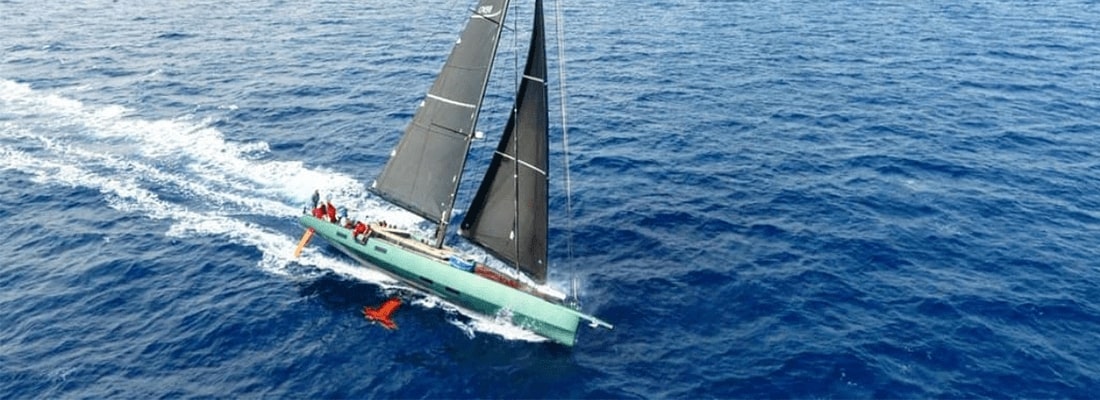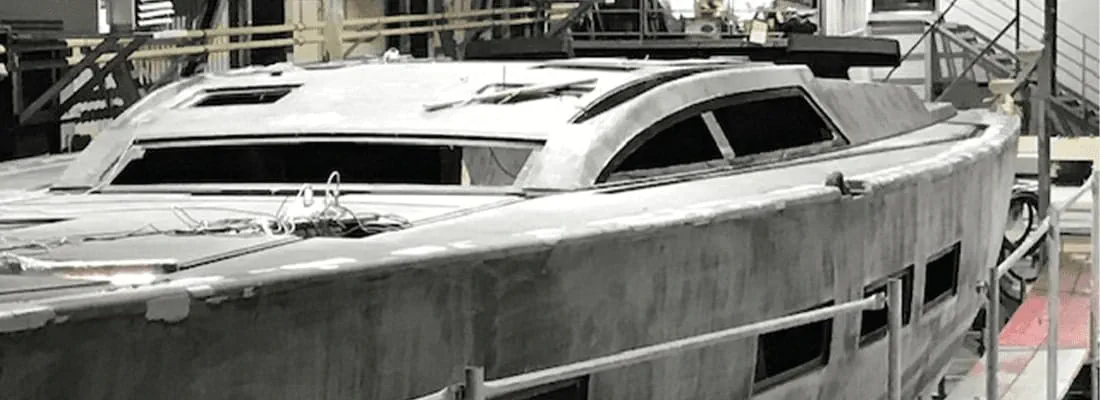Technologically advanced sailboats are often built in carbon and other state-of-the-art materials. The key to a successful project lies within the knowledge of production technologies and building methods. Construction details can make an important difference in terms of design quality. Composite materials have many advantages and can be used to optimize production technologies. Any limitations concerning the design of a product, that arise when using more traditional materials, can be overcome with the use of these newer materials.
A revolution in production processes
Currently, the use of pre-pregs is widespread. Pre-pregs (preimpregnated fibers) were initially developed for aeronautical and aerospace applications, but over the years they have been reformulated and developed to adapt to the needs of the shipbuilding industry. The development of construction techniques, that is the different procedures to obtain the final product, has allowed us to use them for the construction of components that until a few years ago were only feasible in aluminum. The introduction of carbon and polymeric matrices with high mechanical characteristics has imposed a revolution in the production process. The yards have invested with the support of the producers of raw materials.
The use of materials such hemp or flax, highly favours the construction of components provided with an interesting environmental quality and structural strength. The use of bamboo requires more complex moulding techniques, although it gives a stronger aesthetical impact on brush strokes on interiors furniture. Investigating the production units of the yachting sector is not an easy task: the reason is that sometime shipyards are the final assemblers, while many sub-contractors operating exclusively in this industry are not known. Just consider that in the marine sector the main different activities are more than forty, it’s easy to realize how in this area, all the production departments should be taken into account. Investing in innovation and in new manufacturing processes is nowadays a strategical and essential factor to the competitiveness of this sector and to cope with the global economic markets. The sustainability of a complex product is not based only on its innovative contents in environmental terms for each single component, but above all on a global redesigning process of the product as a whole.
Innovation at the Vismara Shipyard
In Italy, there is a shipyard which has a peculiar approach to shipbuilding. The philosophy behind the design is to create vessels that not only have a solid scientific base, but that are created with their hearts, where the owner is the consultant and the aim is a technological boat made with enthousiasm and passion. The dreamer behind this shipyard is Alessandro Vismara, who, after studying naval architecture in Southampton went to Viareggio, worked as a chief engineer at Perini shipyard, in 1984 designed with Luca Taddei his first racer, a ¾ Ton winner “Lace Wing”. From that beginning, the Vismara Shipyard produced more than 150 vessels, both sail and motor, all innovative from design, to materials, to sails. A shipyard whose main values are top craftsmanship and top research, highly sophisticated vessels and continous collaboration with the owner.

Precisely through dialogue with customers, the concept of racing/cruisers was born. Considering that not only the racing professionals but also sailing enthusiasts could be interested in sailing with light and very fast boats, Alessandro Vismara asked himself: “why not transfer the experience of racing to the world of fast pleasure?” Hence the innovative idea of a designer who designs and builds fast racers that are comfortable inside, thanks to interiors with the comforts and spaces typical of cruising boats, but which, by exploiting the correct use of the most advanced materials, meet the expectations of owners who want a boat "tailored" performance.To achieve this goal, that is, combining speed with large spaces below deck, composite materials have been used combined with creativity but also engineering rigor capable of making the most of IT tools, 3D prediction and simulation programs.
Saving costs by working smart
Composite materials have conquered a large part of the world nautical market thanks to a continuous evolution driven by the demand for lightness and speed. It must be clear that it is not enough to use carbon to automatically obtain light and resistant boats. Alessandro is convinced that as the material is expensive, it must be used smartly to consume less and save costs. Structural carbon and interiors covered with fiberglass skin, for high performance cruisers/racers. Thanks to the highly engineered approach and a selection of materials also obtained thanks to the many tests on mechanical characteristics, it is possible to save costs. The shipyard last vessel, Vismara V100 B "Fast Ocean Cruiser" is the first boat with which Vismara Marine enters the world of super yachts. Designed in four hands with its owner in full Vismara style, the boat is built in lightweight composite materials, the result of the best structural integration technologies developed over more than 30 years by the Viareggio shipyard, carbon and epoxy glass. The hull is built in carbon with unidirectional reinforcements and an external fiberglass "skin", the deck is entirely in carbon and the interiors in composite, a correct mix of lightness, durability and silence. Vismara’s maxi yacht is constructed in prepreg/nomex sandwiches using numerical control female moulds. The pre-preg at low temperatures is a material that has a very high efficiency. The close collaboration with the world's leading manufacturers of advanced materials has always supported the yard's research and innovation path.
As Alessandro says:”Innovation means having solid technical bases, that's why in my opinion it is necessary to push on the materials, on the forms, to return to sailing, with small engines, electric propulsion and an ecological approach to the sea. The efficiency is in absorbing little energy from the environment thanks to efficient materials and hulls”.


